IK Multimedia only launched it’s Amplitube iPhone app yesterday, but the download has already stormed into the iTunes top 10 for music-making apps………..
We know you’ve been waiting on pins and needles, and at long last, the gap between announcement and “now shipping” has been closed. IK Multimedia has just revealed that its AmpliTube iRig adapter is shipping, enabling iPod touch, iPad and iPhone users to jack their guitar or bass directly into their iDevice and access all sorts of effects.
Guitarists can purchase the new AmpliTube iRig system for the iPhone, iPod touch, and iPad. The system includes a hardware adapter that lets you plug your electric guitar into the headphone port along with a port on the iRig for headphones so you can listen in private.
AmpliTube iRig. Users can configure a mobile guitar amp with sound effects software hosted on an iPhone. The hardware is an interface adapter for connecting a 1/4-inch plug instrument with the iPhone’s audio port, and outputting to an 1/8-inch stereo feed. The adapter is said to be very rugged, fit for life in a guitar bag.
The iPhone app is described as producing good sound quality, and offering numerous tone design options. It includes 11 stompbox effects, 5 amp models, 5 cabinet models and 2 microphone simulations, all of which can be combined in different ways. It can also store up to 32 presets, though numeric naming may be confusing with large collections of presets. At the same time, a strength of the app is thought to be its clean settings.
IK Multimedia is pleased to announce that AmpliTube® for iPhone, the ultimate mobile guitar amp and effects system for iPhone/iPod Touch/iPad, is now available for download from the iTunes App Store. Together with the iRig interface adapter this represents the first complete solution for guitar and bass players to play, practice, and have fun anytime and everywhere rocking through their iPhone. The combination of AmpliTube mobile app and iRig accessory adapter is called AmpliTube® iRig™, the cutting edge system for the portable guitar and bass multi-effects of the future.
With AmpliTube for iPhone fully loaded, you will be able to choose between 5 amp models (clean, crunch, lead, metal, bass) with full tone and drive controls, 11 stompbox effects (delay, flanger, phaser, overdrive, distortion, filter, wah, fuzz, octaver, chorus, noise filter), 5 speaker cabinets (1×12”, 2×12”, 4×12” A & B”, 1×15) and 2 microphones (dynamic and condenser). Plus, AmpliTube for iPhone features a chromatic digital tuner and a metronome. You can also import and play along with songs or backing tracks, and create, save and recall up to 36 presets on the fly.
The iRig interface adapter is the easiest way to get your instrument’s signal into your mobile device with electrical impedance adapting – this is essential for achieving the best guitar tone. Simply plug iRig into your mobile device, plug your instrument into the iRig, plug headphones or an amplifier to the output and you are ready to rock with no further set-up needed. Plus, you can also use the iRig with line level signal sources such as synthesizers, keyboards or mixers. And not only does the iRig work perfectly with AmpliTube, but it is also the perfect companion to any other guitar or other instrument recording, processing or tuning app that uses an audio input.
As far as performance goes, Amplitube is a sure fire winner. I didn’t notice any such latency and everything about the App responded in a moments notice. There was some slow down here and there when loading stomp boxes and amps but it it wasn’t too bothersome all things considered. One thing I did run into was that you need to extend the auto-shutdown time of your phone as I ran into some issues with Amplitube not knowing what was going on. It does in fact work with the screen shut down (see pic below) but there were times when weird and pervasive digital noise invaded the headphones upon screen shut down. It was very unsettling, so watch out. Other than that, I was impressed with how Amplitube dealt with the live conversion from analog to digital and most guitar players will agree that they’d never imagined playing guitar so smoothly on their IPhones.
The biggest disappoint for me was the quality of the sound reproduction. Way too digital. For the sake of reference, I was using an ESP LTD Viper 400 with Active EMG 81 Pick-Ups. A decently “hot” guitar, I was also using a pair of Sony MDR-7504 Headphones as monitors. At no point was I blown away by the tones produced through Amplitube. However, knowing what you’re doing will definitely help you get the most out of Amplitube and the iRig. Trying to get a suitable clean tone while using the Metal Amp isn’t going to work and vice-versa. You can chain three effects simultaneously in conjunction with an Amp set-up, your cabinet of choice, and either a dynamic or condenser microphone. I liked the Clean and Metal Amp set-ups the best. Crunch and Lead Amps were filed in the “whatever” category but it will largely depend on what type of guitarist your are. I got some real heavy Stoner Metal style tones out of the Crunch Amp but it was rather muddy and useless for more precise and technical playing. Most all clean tones sounded OK with occasional distortion appearing when the strings were hit harder.
If you want to jam along with some of your favorite songs, you can import up to 20 tunes wirelessley provided that your phone and computer share the same wireless network. The app gives you and IP address for you to input into your URL, and then you upload the tracks from there. Overall the process was easy and painless. The preferred format is MP3 but I had no trouble booting up an Mpeg-4. Once the track is in the App it just takes a moment to expand and then it’s forever yours.
All the effects sounded as they should with some being better than others. The wah pedal effect was a bit weak but the envelope filter and octave pedals were killer. The noise suppressor is totally essential and without it your are going to be hearing your fair share of digital hiss, so you need to incorporate it with all of your set ups. When it came to distorted tones, the low gain ones were pretty unbalanced even when set at high gain. During other set up experiments I couldn’t dial in enough treble and everything sounded like it was coming from the neck pick up. They were all pretty harsh, but I honestly wasn’t expecting all that much given the fact that even my MacBook Pro can’t render live tones all that well (Amplitube Metal w/ Pro Tools LE). Changing around the cabinets and microphones will definitely provide some much needed “scooping”, but by and large you are going to find a couple key tones and make them presets and stick with them, in which the App can hold up to 36. It’s quite the astonishing feat that IK Multimedia has succeeded where it has with bringing live guitar to such a small device, and I’m interested in seeing if it will sound any better on the iPhone 4, as I did all my testing on an iPhone 3G and an iPad. I didn’t notice any differences between the two minus the fact that Amplitube has yet to be optimized for the iPad’s larger screen.
iRig features:
- 1/4″ jack mono instruments input with Hi-Z impedance adapter – suitable for guitars, bass, synthesizers, mixing consoles.
- 1/8″ mini-jack stereo output can be connected to headphones, amplifiers, powered speakers.
- Compatible with iPhone 3G, 3GS, 4, iPod touch 2nd and 3rd generation, iPad.
- Ultra-low latency (down to 128 samples) for real time playing with AmpliTube.
- Feedback cancellation and noise filter available in AmpliTube.
- Works also with any other apps like tuners, recorders, etc…
Ultimately we came away quite impressed with the iRig plus AmpliTube combo. The sounds are solid, the interface is intuitive, the featureset is robust and the price is reasonable — especially considering the range of software options and pricing available. Musicians of all stripes from hobbyist to professional could glean a lot of utility from having an on-the-go practice or composition toolbox available right in their iPhone or iPad.
From there, users can pipe the audio to a pair of headphones or a guitar amp, theoretically allowing your handheld to supplant your mess of pedals. We’re also told that the iRig can be used with line level signal sources such as synthesizers, keyboards or mixing consoles, so there’s that. It’s available as we speak for $39.99 (or €29.99 overseas), and users can expect an iPad-specific version of the AmpliTube app to be released in the near future.
Resources :ipodnn.com,gadgetreview.com,engadget.com

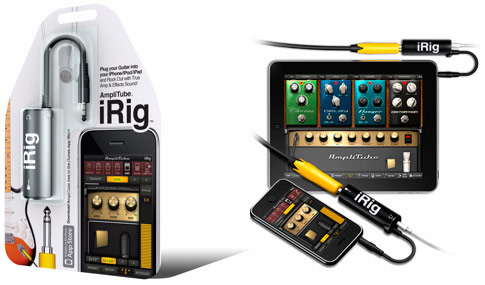
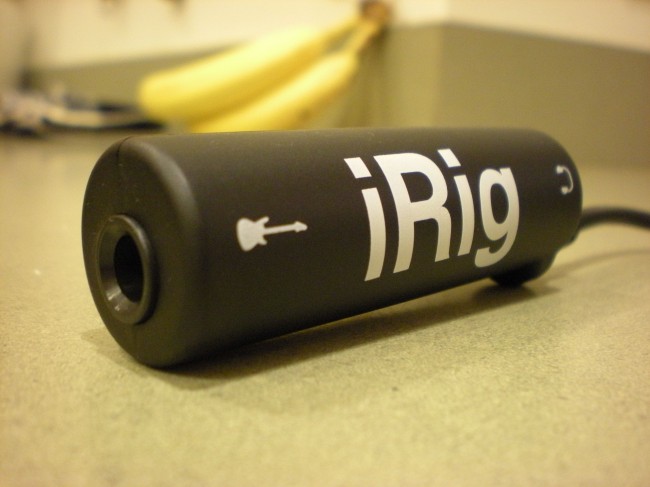
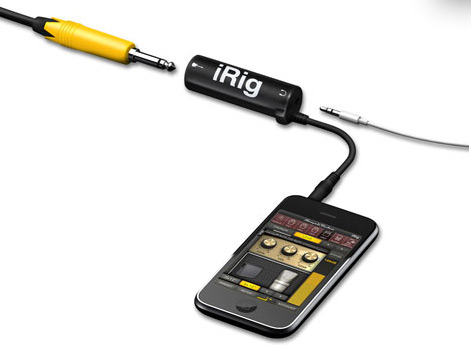
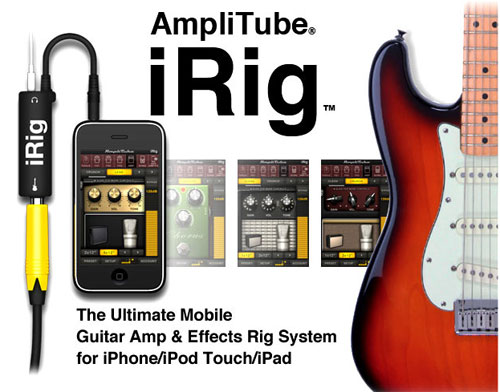
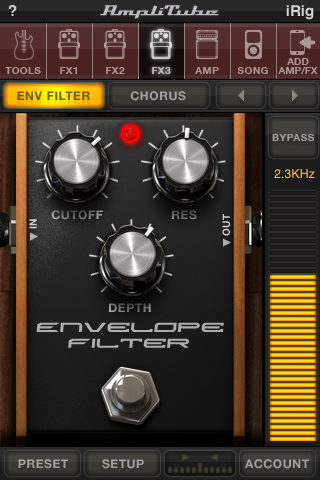
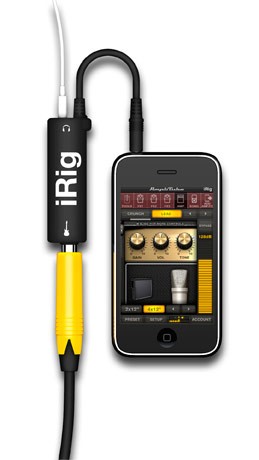
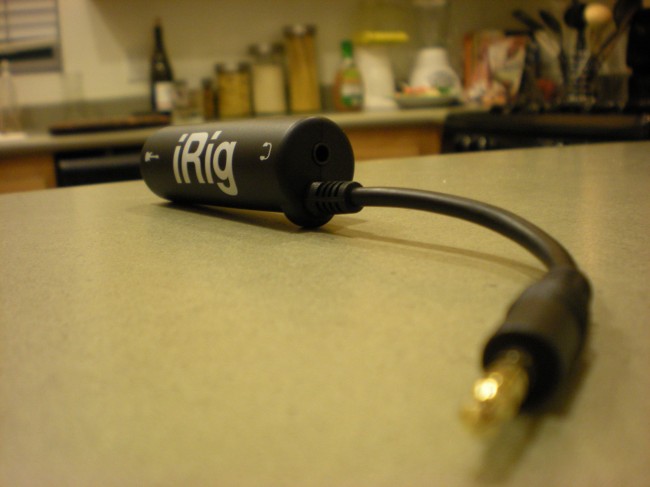

Has anybody noticed that Apple does not use the
“industry standard” spacing on their iPhone 3.5mm, 4 element,
headphone jack (which is a stereo audio/mic connection)? MOST OF THE PROBLEMS
ABOVE MIGHT BE CAUSED BY THAT.
This means that when
you fully insert the iRig connector to your iPhone you will
“sometimes” be disconnecting the mic. If you slide the iRig connector
out slightly (you’ve got to play with it) you’ll get the right connection –
you’ll know because the stereo audio will become a little more faint, as the
mic becomes activated. I use a thin tape wrapping at the base of the iRig’s
male connector shaft – that prevents the plug from going to far.
Take a look at your
iPhone headset 3.5mm, 4 element plug compared to the iRig 3.5mm, 4 element plug
– you’ll see what I mean – the plastic insulation spacing is slightly different
– Apple, only Apple would use a non-industry standard plug. BTW, your iPhone
headset works perfectly with the AmpliTude App.
Can anyone please tell me how to change from headphone to speaker mode? It does not prompt me anymore and my speaker doesn’t work but my headphones do. Thanks.
This app is somewhat difficult to get used to, and thus many people believe that it doesn’t work. It does in fact work for many people. I would advise getting the free version first. A common problem is the effects turned off. Go to the Rec., hit “Mixer” at the bottom, and make sure that the “FX” light is on for Track 1.
What I don’t like about this product is that because it puts the input and output into the same jack, feedback is a big problem. Without the Noise Reducer, your product will sound like crap, and even with it, you get odd echoing hisses on a constant basis.
The software is great, but the iRig hardware is limited by the iOS device’s combined input/output jack.
Купить в Санкт-Петербурге за 1000р.
http://vk.com/amplitube_irig